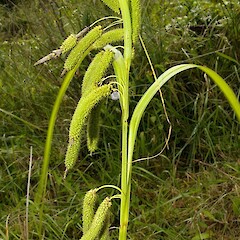Carex lessoniana
Common name
rautahi, cutty grass
Synonyms
Carex polystachya A.Rich.
Family
Cyperaceae
Flora category
Vascular – Native
Endemic taxon
Yes
Endemic genus
No
Endemic family
No
Structural class
Sedges
NVS code
The National Vegetation Survey (NVS) Databank is a physical archive and electronic databank containing records of over 94,000 vegetation survey plots - including data from over 19,000 permanent plots. NVS maintains a standard set of species code abbreviations that correspond to standard scientific plant names from the Ngä Tipu o Aotearoa - New Zealand Plants database.
CARLES
Current conservation status
The conservation status of all known New Zealand vascular plant taxa at the rank of species and below were reassessed in 2017 using the New Zealand Threat Classification System (NZTCS) – more information about this can be found on the NZTCS website. This report includes a statistical summary and brief notes on changes since 2012 and replaces all previous NZTCS lists for vascular plants.
Please note, threat classifications are often suggested by authors when publications fall between NZTCS assessment periods – an interim threat classification status has not been assessed by the NZTCS panel.
- Conservation status of New Zealand indigenous vascular plants, 2017 . 2018. Peter J. de Lange, Jeremy R. Rolfe, John W. Barkla, Shannel P. Courtney, Paul D. Champion, Leon R. Perrie, Sarah M. Beadel, Kerry A. Ford, Ilse Breitwieser, Ines Schönberger, Rowan Hindmarsh-Walls, Peter B. Heenan and Kate Ladley. Department of Conservation. Source: NZTCS and licensed by DOC for reuse under the Creative Commons Attribution 4.0 International licence.
2017 | Not Threatened
Previous conservation statuses
2012 | Not Threatened
2009 | Not Threatened
2004 | Not Threatened
Distribution
Endemic. New Zealand: North Island (widespread), South Island (more common in the northern half, sporadic further south).
Habitat
Coastal to lowland (rarely montane). Usually on the margins of peat swamps, or in very wet alluvial forest.
Wetland plant indicator status rating
Information derived from the revised national wetland plant list prepared to assist councils in delineating and monitoring wetlands (Clarkson et al., 2021 Manaaki Whenua – Landcare Research Contract Report LC3975 for Hawke’s Bay Regional Council). The national plant list categorises plants by the extent to which they are found in wetlands and not ‘drylands’. The indicator status ratings are OBL (obligate wetland), FACW (facultative wetland), FAC (facultative), FACU (facultative upland), and UPL (obligate upland). If you have suggestions for the Wetland Indicator Status Rating, please contact: [Enable JavaScript to view protected content]
FACW: Facultative Wetland
Usually is a hydrophyte but occasionally found in uplands (non-wetlands).
Detailed description
Rhizomatous; robust, 0.5–1.5 m tall, bright green to dark green. Culms 1.5–5.0 mm diameter, triquetrous, scabrid on the edges; basal sheaths dull brown or red-brown, margins shredding into fibres wrapped round the culm. Leaves numerous usually much > culms, 3.5–8.0 mm wide, double-folded, margins scabrid. Spikes 6–20, pendulous on filiform peduncles, or upper spikes erect, sessile; upper 3–6 spikes male, sometimes mixed with female flowers, solitary or the lower geminate, 2–4 mm diameter, glumes hardly awned; remaining spikes female, usually with male flowers at the top, geminate, ternate or occasionally quinate, lowermost spikes 20–90 × 4–7 mm, upper spikes progressively smaller. Glumes (excluding awn) < utricles, narrow-ovate, obtuse, truncate or emarginate with a hispid awn of variable length, red-brown with a light brown, 3-nerved midrib, margins narrow, hyaline. Utricles 2.6–3.8 × 1.3–2.3 mm, ovoid to oblong, saccate, inflated or unequally compressed, 6–10-nerved on each face, olive green, becoming greenish brown or red-brown, soft, margins glabrous; beak very narrow, c. 0.2 mm long, orifice entire, rarely slightly bidentate. Stigmas 2. Nut c. 1.5 mm long, in lower half of utricle, biconvex, orbicular-ovoid or obovoid, brown.
Similar taxa
Carex lessoniana is allied to C. coriacea Hamlin, C. ternaria Boott, and C. geminata Schkuhr. From all these species it can be distinguished by the compact inflorescences, with wider, though smaller, initially erect spikelets (the basal few are always pendulous), and by distinctly beaked utricles. However, in some specimens the beak can be minute. Carex ternaria is unlikely to be confused because it confined to the Chatham and Subantarctic islands outside the range of C. lessoniana. Carex lessoniana and C. geminata often overlap ecologically, although C. lessoniana is more common in wetter and/or more acidic habitats—such as peat bogs. Only rarely do the ranges of C. lessoniana and C. coriacea overlap, and then only in the south-eastern limits of its range.
Flowering
October–December
Fruiting
December–April
Life cycle
Nuts surrounded by inflated utricles are dispersed by granivory and wind (Thorsen et al., 2009).
Propagation technique
Easily grown from fresh seed and by the division of established plants. Although a wetland species C. lessoniana will grow well in most soils and moisture regimes. Does best in partial shade.
Etymology
carex: Latin name for a species of sedge, now applied to the whole group.
lessoniana: Named after René Primevère Lesson who was a 19th century French botanist and surgeon
Attribution
Fact Sheet prepared by P.J. de Lange (10 August 2006). Description adapted from Moore and Edgar (1970)
References and further reading
Moore LB, Edgar E. 1970. Flora of New Zealand, Volume II. Indigenous Tracheophyta: Monocotyledones except Gramineae. Government Printer, Wellington, NZ. 354 p.
Thorsen MJ, Dickinson KJM, Seddon PJ. 2009. Seed dispersal systems in the New Zealand flora. Perspectives in Plant Ecology, Evolution and Systematics 11: 285–309. https://doi.org/10.1016/j.ppees.2009.06.001.
NZPCN Fact Sheet citation
Please cite as: de Lange, P.J. (Year at time of access): Carex lessoniana Fact Sheet (content continuously updated). New Zealand Plant Conservation Network. https://www.nzpcn.org.nz/flora/species/carex-lessoniana/ (Date website was queried)


